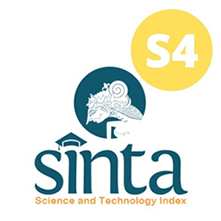Pulse Oximeter Design for SpO2 and BPM Recording on External Memory to Support the Covid-19 Diagnosis
Abstract
COVID-19 (coronavirus disease) is an acute respiratory illness induced by exposure to coronavirus 2 in 2019 (SARS-CoV-2). WHO confirms that there were 1.8 million registered deaths in 2020 and that there were 3.5 million recorded deaths in 2021. People who are infected with SARS-CoV-2 without symptoms should have a pulse oximeter. Early detection of low oxygen levels in the blood can lead to fewer complications. Continuously decreasing oxygen saturation, if not controlled, will cause hypoxia (an abnormal respiratory circulation system condition that causes breathlessness). In normal conditions, oxygen levels and heart rate are related. When a person has a shortage of oxygen (breathlessness), their heart rate increases to supply the oxygen. Regulating heart rate can aid in the prevention of disorders such as arrhythmia, coronary heart disease, and hypertension. A pulse oximeter is used to measure the oxygen saturation in the blood and the patient's heart rate (BPM) with non-invasive methods. Conventional pulse oximeters do not support users by not having features such as medical records, which are required for further examination by a doctor. The purpose of this research is to make a pulse oximeter with external storage capability. The difference in wavelength between the red and infrared LED lights that will be captured by the photodiode is measured. SpO2 and HR values will be generated as a result of comparative measurements. Using a MAX30102 sensor to detect SpO2 and heart rate, and an Arduino Mega256 to process data for display on the TFT Nextion with Memory Card storage. By comparing the module to a conventional pulse oximeter, data was collected 10 times for each respondent. The maximum SpO2 error value is 0.43%, whereas the BPM parameter has the largest error value of 2.02% and the smallest error value of 0.01% based on the data collected. A significant error value is caused by finger movement. The module is usable, based on the results, because the maximum error tolerance for a pulse oximeter is 1% SpO2 and 5% BPM, according to the 2001 Ministry of Health Ministry's Guidelines for Testing and Calibrating Medical Devices.

This work is licensed under a Creative Commons Attribution-ShareAlike 4.0 International License.
Authors who publish with this journal agree to the following terms:
- Authors retain copyright and grant the journal right of first publication with the work simultaneously licensed under a Creative Commons Attribution License that allows others to share the work with an acknowledgement of the work's authorship and initial publication in this journal.
- Authors are able to enter into separate, additional contractual arrangements for the non-exclusive distribution of the journal's published version of the work (e.g., post it to an institutional repository or publish it in a book), with an acknowledgement of its initial publication in this journal.
- Authors are permitted and encouraged to post their work online (e.g., in institutional repositories or on their website) prior to and during the submission process, as it can lead to productive exchanges, as well as earlier and greater citation of published work (See The Effect of Open Access).











